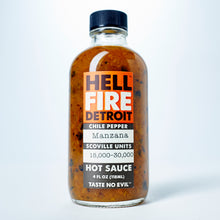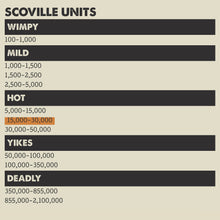Exotic nose with a fiery smack.
15,000–35,000 Scoville Units (Hot)
Ingredients: Fire-roasted Manzana, apple cider vinegar, distilled water, olive oil, sea salt.
All-natural, vegan, vegetarian, gluten free and low sodium (60mg). No preservatives, gums, extracts, fat, or sugar.
About Manzana
The Manzana chile pepper, also known as Rocoto, Manzano, and Peron, is a rare type of chile pepper. In Spanish, Manzana translates to mean apple, a nod to the pepper’s apple-like shape. Unlike most chiles cultivated in Mexico, the Manzana chile is not a part of the common botanical family of Capsicum annuum, but rather a part of Capsicum pubescens, a species of pepper from the Andes region. This species is unique in the fact that the leaves of the pepper plant are covered in fine hairs and the seeds of the peppers are black in color.
Depending upon variety, the Manzana chile pepper ranges in color from light green when immature to bright yellow, orange and red when ripe. Its heat level can vary from mild to hot depending upon the specific variety and maturity of the pepper. Like many peppers, the Manzana can be used when immature, but it is most commonly utilized in its fully mature stage. Scoville units range between 10,000 and 30,000 on average. Removing the seeds and membrane of the Manzana chile pepper will reduce the heat. Its flesh is soft offering a meaty texture and its aroma and flavor are pungent with fruit like nuances.
The spice and flavor of the Manzana pepper marry well with lime, avocados, onion, oregano, tomatoes, cheese, cornmeal, sweet potatoes, fish and grilled meats.
The pepper dates back to the ancient civilizations of the Andes mountain region of Chile and Argentina. Colonial historians note it was at that time known as Rocoto pepper. In addition to ancient texts that describe the pepper, what is believed to be images of the Manzana can be found on prehistoric pottery and tapestries found in the Andes region.
The Manzana chile thrives in the 6,000 – 10,000 foot altitude level. At lower levels the pepper will produce some fruits but very few with seeds. At higher levels, the temperature is too low for plants to be successful. In addition to the Andes region, today the pepper is grown in high elevation parts of Mexico such as Guerrero, Queretaro, and Chiapas. On average, Manzana pepper plants can be maintained as a perennial for four to five years with older plants offering a higher yield of peppers.
Source (edited): specialtyproduce.com
Shipping & Returns
Shipping > USPS Priority Mail®
1-5 bottles: $9.75 (U.S.)
Orders over $100 = Free Shipping (U.S.)
For larger or wholesale orders, please contact us.
International shipping rates based on country, weight, and value.
For your safety, all sales are final.
Not responsible for lost or stolen packages.



